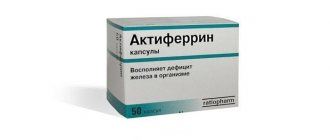1887
Author of the article
Evgeniy Nikolaevich Konoplev
Reading time: 3 minutes
AA
With age, the load on the heart increases; due to frequent stress, interruptions in blood circulation occur, veins and arteries narrow. In such cases, doctors recommend the use of drugs that purify the blood and remove platelet deposits on the walls of blood vessels. Such drugs include Prazosin. It blocks alpha adrenergic receptors and dilates blood vessels.
Prazosin
The drug Prazosin is a peripheral vasodilator.
It is a blocker of postsynaptic α1-adrenergic receptors and prevents the vasoconstrictor effect of catecholamines. Lowers blood pressure by reducing peripheral vascular resistance and reduces afterload on the heart. Dilates peripheral veins, also reducing preload on the heart. Improves systemic and intracardiac hemodynamics in patients with chronic heart failure. Reduces pressure in the pulmonary circulation. The vasodilating effect of prazosin is accompanied by moderately severe reflex tachycardia. With long-term administration, it reduces the concentration of atherogenic lipids in the blood. Reduces myocardial oxygen demand and increases stroke volume during physical activity. Reduces renal vascular resistance. Reduces resistance and pressure in the urethra (by relaxing the smooth muscles of the bladder neck, prostate gland and its capsule), which leads to a weakening of the severity of symptoms of urinary tract dysfunction. The maximum hypotensive effect after taking a single dose develops after 1-4 hours, the duration of action is up to 10 hours. Both early (3-5 days) and late (by 12 months) tolerance can develop, which requires an increase in the dose. Indications for use: Prazosin is intended for the treatment of arterial hypertension, chronic heart failure (as part of combination therapy), Raynaud's syndrome and disease; pheochromocytoma, peripheral vascular spasms due to ergot alkaloid poisoning. Prostatic hyperplasia.
Directions for use: Prazosin is taken orally. The initial dose is 0.5–1 mg before bedtime in a horizontal position, then 1 mg 2–3 times a day. At intervals of 5–7 days, the daily dose can be increased to 6–15 mg (in 2–3 doses), the maximum daily dose is 20 mg, the maximum effect occurs after 4–6 weeks.
Side effects: Side effects from the use of Prazosin can be from the cardiovascular system: arterial hypotension (especially orthostatic), palpitations, anginal pain, tachycardia, shortness of breath; with prolonged use, swelling of the lower extremities is possible; in rare cases, orthostatic collapse (especially when taking the first dose). From the central nervous system and peripheral nervous system: dizziness, headache, sleep disorders, weakness, fatigue, anxiety, depression, paresthesia, hallucinations, perceptual disturbances, emotional disorders. From the digestive system: dry mouth, nausea, vomiting, diarrhea, constipation. From the urinary system: frequent urination. From the senses: tinnitus, darkening of the eyes, blurred vision, hyperemia of the conjunctiva and cornea. Allergic reactions: itching, skin rash. Other: nasal congestion, epistaxis, hyperthermia, hyperhidrosis, alopecia, priapism, decreased potency, the appearance of antinuclear factors, arthralgia.
Contraindications: Prazosin is contraindicated in cases of hypersensitivity, hypotension, constrictive pericarditis, cardiac tamponade, heart disease with reduced left ventricular filling pressure, pregnancy, lactation, children (up to 12 years).
Interaction with other drugs: When using Prazosin with beta-blockers, calcium channel blockers, ACE inhibitors, there is a risk of developing severe arterial hypotension, especially after the first dose of prazosin. The vasodilating effects of alpha-blockers and calcium channel blockers may be additive or synergistic. With simultaneous use of prazosin and verapamil, the development of severe arterial hypotension is partly due to pharmacokinetic interaction: an increase in Cmax and an increase in AUC of prazosin. When used simultaneously with digoxin, the concentration of digoxin in the blood plasma quickly and noticeably increases. When used simultaneously with indomethacin, the effectiveness of prazosin may be reduced. When used concomitantly with clonidine, the antihypertensive effect of clonidine may be altered. Patients receiving propranolol are at risk of developing severe hypotension after taking the first dose of prazosin.
Pregnancy: Prazosin is contraindicated for use during pregnancy and lactation (breastfeeding).
Overdose Overdose with Prazosin has not been described.
Storage conditions: In a dry place, protected from light, at a temperature below 25 °C. Keep out of the reach of children.
Release form: Tablets 0.5 mg; polypropylene bottle (bottle) 30 box (box) 1; Tablets 1 mg; polypropylene bottle (bottle) 30 box (box) 1;
Composition: 1 tablet contains prazosin 0.5 or 1 mg; in bottles of 30 pcs., in a box 1 bottle.
Pharmacodynamics and pharmacokinetics
According to the instructions, Prazosin has the following effects on the body:
- blocking postsynaptic α1-adrenergic receptors;
- reducing the vasoconstrictor effect of catecholamines;
- decrease in total peripheral vascular resistance and decrease in blood pressure;
- expansion of peripheral veins;
- reduction of afterload on the heart;
- decreased pressure in the pulmonary circulation;
- improvement of intracardiac and systemic hemodynamics in chronic heart failure;
- decreased myocardial oxygen demand and increased stroke volume during exercise;
- decreased renal vascular resistance;
- reducing pressure and resistance in the urethra and reducing the severity of symptoms of urinary tract dysfunction.
Taking the drug may be accompanied by the development of moderate reflex tachycardia. With long-term use, a decrease in the concentration of atherogenic lipids in the blood is observed.
After taking a single dose, the maximum hypotensive effect develops within 1–4 hours. The duration of action of the drug is up to 10 hours. During treatment, early (after 3–5 days) or late (by 12 months) tolerance may develop, so the doctor may decide to increase the dose.
The drug is quickly absorbed from the gastrointestinal tract (food intake does not affect absorption). The maximum concentration in the blood is achieved within 1–3 hours. The bioavailability of Prazosin ranges from 50 to 85%, binding to plasma proteins exceeds 95%. The drug is metabolized in the liver.
The half-life of Prazosin is from 2 to 4 hours. The drug is excreted primarily in bile. In patients with chronic renal failure and elderly patients, the half-life is prolonged.
Directions for use and dosage
Prazosin is taken orally at a convenient time without reference to meals.
Treatment of arterial hypertension begins with 0.5 mg 1 time per day, the tablet should be taken before bedtime. Next, the dose is gradually increased, first to 1 mg 3-4 times a day, then gradually to the dose that will achieve a stable reduction in blood pressure. Typically, the dose titration period lasts 4-8 weeks. The optimal daily dose for the patient can range from 3 to 20 mg, but most often ranges from 6 to 15 mg. The maintenance daily dose should be divided into 3-4 doses.
In cases where Prazosin is used as monotherapy, the likelihood of developing tolerance, which may occur on days 3-5 of treatment or after several months, should be taken into account. With such a reaction, an increase in the dose of prazosin or additional administration of diuretics is necessary.
If the hypotensive effect develops too slowly, or when taking Prazosin alone, the antihypertensive effect is not sufficient, diuretics or other antihypertensive drugs are additionally prescribed. In this case, it is necessary to first reduce the dose of prazosin to 1-2 mg 3 times a day, then add a second drug, and then gradually increase the dose of prazosin until a suitable therapeutic regimen is selected.
The duration of treatment is determined individually; there are no restrictions on the duration of taking the drug.
Patients with congestive heart failure, depending on the clinical situation, are prescribed a daily dose of 3 to 20 mg in 3-4 doses.
The highest daily dose for adults should not exceed 20 mg.
Prazosin: instructions for use, price, reviews, analogues, mechanism of action and side effects
Prazosin is a drug that has vasodilating and antihypertensive effects. The medication is available in tablet form. The dosage of the medicine is determined according to individual indications in specific cases. Most often, the dose can be adjusted, since the drug quickly causes the body’s tolerance to the main component.
General characteristics
Prazosin is a drug belonging to the group of alpha-1 adrenergic blockers and containing the active substance of the same name. It is used for chronic heart failure, vascular problems, prostate hyperplasia and some other disorders. The international nonproprietary name of the product, identical to the main active component, is Prazosin.
Forms and cost
The product is produced in the form of tablets with a dosage of the active substance of 1 and 5 mg. In addition, the drug contains starch, magnesium stearate, monohydrate, silicon dioxide, lactose. The medicine is available in bottles with different numbers of tablets: 30, 50 and 100 pieces.
At the moment, Prazosin is not available for free sale in Russian pharmacies, so the exact cost of the product is impossible. In Ukraine, this drug can be purchased for about 30-40 UAH. 30 pcs.
Pharmacodynamics and pharmacokinetics
The main active component of the tablets is prazosin. The substance is a peripheral vasodilator. It has the following therapeutic effects:
- decreased blood pressure;
- reduction of preload on the heart muscle;
- improvement of intracardiac and systemic hemodynamics, which is especially important in chronic heart failure;
- decreased myocardial oxygen demand;
- increase in blood volume during physical activity;
- reduction of symptoms of urinary tract dysfunction.
The maximum hypotensive effect after taking a single dose develops over 1-4 hours. The duration of the effect is about 10 hours. The drug may cause the development of tolerance to it, so dosage adjustment is required in the direction of increasing it.
The effect is due to the ability of the main component to block alpha-1 adrenergic receptors, as well as to prevent the vasoconstrictor effects of sympathetic innervation.
Prazosin simultaneously dilates both arteries and veins. To a slightly greater extent it affects large venous vessels. This reduces peripheral resistance, thereby facilitating the work of the heart muscle.
The medicine is quickly absorbed from the gastrointestinal tract, and meals do not affect absorption. The drug is metabolized in the liver. It is excreted primarily in bile.
Indications and contraindications
The medicine is recommended for the following conditions and abnormalities:
- arterial hypertension;
- chronic heart failure;
- Raynaud's syndrome;
- BPH;
- peripheral vasospasm caused by ergot alkaloid poisoning;
- pheochromocytoma (tumor of hormonal nature).
Contraindications to taking pills are:
- low blood pressure;
- chronic heart failure caused by constrictive pericarditis;
- hypersensitivity to the main active ingredient and auxiliary components;
- heart muscle defects, accompanied by reduced pressure during filling of the left ventricle;
- children under 12 years of age;
- cardiac tamponade;
- periods of pregnancy and lactation.
Before starting use, you must consult your doctor to determine if there are any contraindications to use.
Instructions for use of the medicine
During treatment with Prazosin, blood pressure and heart rate should be constantly monitored. The dosage is calculated by a specialist.
Dosage
The initial dose is 0.5 mg. The drug in the indicated dose is taken before bedtime. As the therapeutic course continues, this dose is increased to 1 mg 3-4 times a day.
In the future, if necessary, the dosage can be increased to 20 mg. With this method of treatment, it is possible to achieve a stable reduction in blood pressure in 4-8 weeks.
Restrictions on the use of the drug
If Prazosin is prescribed as a single drug, not as part of a complex treatment, then tolerance to it may develop. It can occur at the initial stage of treatment (on days 3-5) or after several months. This phenomenon requires either an increase in dose or additional administration of diuretics.
If, when taken, the hypotensive effect is insufficient or develops too slowly, then other drugs with a similar effect are additionally prescribed. At the same time, they do not stop taking Prazosin: its dosage is only reduced. After correction, it is 1-2 mg of the drug, which should be taken three times a day.
The duration of use of this medication is not limited, but, as a rule, it is at least a month.
Compatibility with other drugs
If a patient is using Prazosin, he needs to become familiar with how this drug is combined with other medications.
- when Prazosin is combined with calcium channel blockers, beta-blockers, ACE inhibitors, there is a risk of a pronounced decrease in blood pressure, especially after the first dose;
- parallel use of Prazosin and Clonidine may cause changes in the antihypertensive effect of the latter;
- if you combine Prazosin with Indomethacin, there is a risk of reducing the effectiveness of the first drug.
Side effects
When taking the drug, the following side effects may occur:
- a sharp decrease in blood pressure;
- rapid heartbeat;
- tachycardia;
- dyspnea;
- swelling of the legs;
- dizziness;
- general weakness and increased fatigue;
- headache;
- disturbances of perception;
- sleep disorders;
- hallucinations;
- increased anxiety;
- depressive states;
- emotional instability;
- dry mouth;
- diarrhea or constipation;
- frequent urination;
- noise in ears;
- skin rash and itching;
- visual impairment;
- darkening of the eyes;
- attacks of nausea and vomiting;
- nasal congestion;
- nosebleeds;
- in men - impaired potency.
When taking too large doses of the drug, a sharp and pronounced decrease in blood pressure is possible. Under such conditions, you should take a horizontal position and raise your legs up. You can also drink warm sweet tea. If these measures do not help, you need to call an ambulance.
Analogs
Structural analogues of the drug are the following drugs:
- Adverzuten. The active substance is prazosin hydrochloride. Available in tablet form. Belongs to the group of antihypertensive drugs. There is no data on the availability of the product in Russian pharmacies.
- Novo-prazin. The main component is prazosin. Available in tablets. Novo-prazin is also currently not available in pharmacy chains in the Russian Federation;
- Minipress. This drug contains prazosin. Dosage form: tablets. The medicine and its analogues are not commercially available.
- Polpressin. The active substance and release form are similar to those drugs described above. Polpressin is not available in pharmacies.
- Prazosinbene. The active ingredient is prazosin, available in tablets. Not available in pharmacies.
- Pratsiol. It has similar active ingredients, dosage form and therapeutic effects. Not available in pharmacies.
Prazosin analogue drugs that have a similar effect are:
- Doxazosin. The drug contains the active substance of the same name. Available in tablets. The actions of the drug are hypotensive, vasodilating, antispasmodic and hypolipidemic. The cost of Doxazosin is about 170 rubles (30 tablets) or 730 rubles (90 pieces).
- Jenocard. The active ingredient is doxazosin. Dosage form: tablets. Used for arterial hypertension and benign prostatic hyperplasia. The remedy was not found in pharmacies.
- Urapidil. The product contains the active component of the same name. Available as an intravenous solution. The cost is the same as for the drug Ebrantil in solution form.
- Cardura. The medication contains doxazosin. Release form: tablets. Price – 450 rubles (30 tablets).
- Artesin. The medicine contains doxazosin and is available in tablet form. The cost of the drug is about 400 rubles for 30 pieces.
- Ebrantil. The drug contains urapidil. Release form: solution for intravenous injection and capsules with different contents of the main active ingredient (30, 60 and 90 mg). This product has no structural analogues for the main active ingredient. The cost of the product in the form of a solution is about 830 rubles (5 ampoules of 5 ml). Ebrantil in capsule form was not found in pharmacies.
- Setegis. The medicine contains an active substance such as terazosin. Release form: tablets. The cost of the product in a dosage of 2 mg is 910 rubles (30 pieces), in a dosage of 5 mg - 1430 rubles (30 pieces).
The possibility of replacing the original drug with an analogue is determined exclusively by the attending physician.
Reviews from doctors and patients
Sergey Vitalievich Reznichenko, cardiologist: “Prazosin is an effective remedy that helps reduce blood pressure and is suitable for long-term treatment. During treatment, it is necessary to regularly monitor blood pressure to prevent it from decreasing too much. Prazosin is effective, but it has an extensive list of side effects.
Previously, patients often complained about this. In addition, the presence of contraindications to taking the drug should be taken into account. The medicine Prazosin cannot currently be found in pharmacies. This is due to the fact that the registration of this drug has expired. But it can be completely replaced by an analogue based on the mechanism of action based on doxazosin.”
Elena Leonidovna Marchuk, vascular surgeon: “Prazosin-based drugs effectively cope with the problem of high blood pressure. Prazosin was previously available in tablet form. The dosage of this drug is always determined on an individual basis, with the minimum permissible dose being prescribed first.
This medicine usually causes tolerance, that is, the body gets used to this drug, and therefore requires regular adjustment of the prescribed dose. Prazosin has enough analogues, both in terms of the active component and the principle of action, so it is quite possible to replace it with another similar medicine.”
Alla, 46 years old: “Previously, I was prescribed Prazosin tablets to combat high blood pressure. This drug served its purpose quite well, but personally it caused side effects for me. They were quite varied: I suffered from attacks of nausea, dizziness, and abdominal pain.
In addition, severe dry mouth constantly occurred. I used this drug for quite a long time - 2 months, after which the condition returned to normal for a long time. Currently, if necessary, they use an analogue of action, since Prazosin cannot be found in the pharmacy.”
Eduard, 54 years old: “The doctor prescribed Prazosin to me to stabilize my blood pressure. The tablets helped for some time, then the effect disappeared. When I went to the doctor, he explained this as “the phenomenon of drug tolerance.”
This means that the medicine is addictive, and this can occur both at the initial stage of therapy and after several months or weeks. In my case I had to increase the dosage. This gave a positive result. Now I’m taking the analogue Doxazosin as maintenance therapy.”
The drug Prazosin helps lower blood pressure and allows you to achieve lasting results. These tablets are suitable for long-term use. At the moment, this product is not available in pharmacies, which is due to the expiration of its state registration, but you can select its structural analogue or an analogue in action and effect.
Loading... Project expert (obstetrics and gynecology)
Education:
- 2009 – 2014, Donetsk National Medical University named after. M. Gorky
- 2014 – 2021, Zaporozhye State Medical University (ZDMU)
- 2017 – present, I am completing an internship in obstetrics and gynecology
Attention! All information on the site is posted for informational purposes only. Do not self-medicate. At the first signs of illness, consult a doctor for advice. Do you still have questions after reading the article? Or you see an error in the article, write to the project expert.
Source: https://simptomov.com/preparat/kardiologiya/antigipertenzivnye/prazozin/
Side effects
- Allergic reactions: skin rashes, itching;
- From the senses: tinnitus, darkening of the eyes, hyperemia of the cornea and conjunctiva, blurred vision;
- From the digestive system: constipation or diarrhea, nausea, dry mouth, vomiting;
- From the urinary system: frequent urination;
- From the cardiovascular system: arterial hypotension (especially orthostatic), tachycardia, shortness of breath, palpitations, anginal pain; with long-term treatment – swelling of the lower extremities; in rare cases - orthostatic collapse (usually after taking the first dose);
- From the central and peripheral nervous system: sleep disorders, vertigo, emotional disorders, weakness, hallucinations, headache, anxiety, fatigue, depression, paresthesia, perceptual disturbances;
- Other: alopecia, nosebleeds, nasal congestion, arthralgia, hyperhidrosis, the appearance of antinuclear factors, hyperthermia, priapism, decreased potency.
Drug interactions
In case of simultaneous use, indomethacin may reduce the effectiveness of prazosin, and beta-blockers, sympatholytics and diuretics enhance its effect.
After taking the first dose of prazosin, patients receiving propranolol may develop severe arterial hypertension.
Beta-blockers, angiotensin-converting enzyme inhibitors, and calcium channel blockers received simultaneously increase the likelihood of developing severe arterial hypotension. The risk is especially high after taking the first dose of prazosin.
Prazosin is incompatible with nifedipine.
The vasodilating effect of calcium channel blockers and alpha-blockers may be additive or synergistic. When prazosin is used in combination with verapamil, severe arterial hypotension may develop, which is partly due to their pharmacokinetic interaction (an increase in the maximum and total concentration of prazosin is noted).
Prazosin can alter the antihypertensive effect of clonidine and significantly increases the concentration of digoxin in the blood plasma.
Analogs
During therapy, you need to constantly monitor your blood pressure and heart rate. The drug can only be combined with sympatholytics and diuretics. Other drugs may make side effects worse. Store the tablets in a dry, dark place at a temperature of 25 degrees. The shelf life does not exceed three years.
Known analogues of Prazosin: Eurex, Pratsiol, Minipress and Adverzuten. In pharmacies, tablets are dispensed only with a doctor's prescription, but they are rarely found in the public domain. Usually the price of Prazosin is 150−230 rubles.
Directions for use and dosage
The drug is taken orally, the initial single dosage is equal to 0.5 mg, taken 2-3 times a day. Subsequently, the dose of the drug is gradually increased to the required optimal value to ensure a hypotensive effect. A persistent decrease in blood pressure is observed after 4-6 weeks; the maintenance dosage is selected individually within the range of 3-20 mg per day, divided into several doses.
As indicated in the instructions for Prazosin, during monotherapy, tolerance to the drug may develop: early - on the third to fifth day of administration, late - after several months of treatment; in such cases, it is recommended to prescribe diuretics or increase the single dose (by 1 mg or more). If the effectiveness of the drug is insufficient or slowly manifested, diuretic or antihypertensive drugs may also be prescribed at the same time. The dosage of Prazosin is reduced to 1-2 mg, taken three times a day, then it is gradually increased to the optimal one.
For the treatment of CHF, Prazosin is prescribed according to the usual regimen: an initial dose of no more than 0.5 mg per day, then a gradual increase to 3-20 mg per day, used 2-3 times. When using the tablets for the first time, after taking them the patient must remain in bed for more than 2 hours due to the risk of postural hypotension - a sharp decrease in blood pressure, up to a short-term loss of consciousness.
When treating Raynaud's syndrome, the medicine is usually taken at 0.5 mg at the beginning of the course, and then the dosage is increased to 1-2 mg twice a day, the maximum daily dose is 6 mg. For the symptomatic treatment of dysuric disorders due to prostatic hypertrophy, Prazosin is prescribed twice a day: 0.5 mg during the first week, 1 mg during the second, 2 mg from 3 to 6 weeks.
To eliminate spasms of peripheral arteries caused by poisoning with ergot alkaloids, the drug is prescribed 1 mg three times a day.
Prazosin will help with high blood pressure
The drug called “Prazosin” is considered an antihypertensive alpha-blocking drug that can be used to treat hypertension as well as congestive heart failure.
Characteristic of the action of the drug is mainly peripheral vasodilation. The tablets can simultaneously have an arterio- and venodilator effect.
Significantly reduces venous blood flow to the heart, which has a beneficial effect on the work of this organ, because there is a decrease in peripheral resistance, a decrease in end-diastolic pressure due to the expansion of peripheral veins, as well as a decrease in blood flow to the right atrium, and lowers blood pressure in the aorta due to a decrease level of peripheral vascular resistance on the myocardium.
This medicine does not cause a decrease in cardiac output.
Unlike other alpha-blockers, tablets do not provoke the development of tachycardia.
Instructions for use
“Prazosin” is a highly effective medication that can be used in the treatment of a disease such as arterial hypertension.
The medicine is quite effective in various forms of manifestation of this disease. It can also be used to treat congestive heart failure.
Method of administration and dose
This drug should be taken orally, regardless of meals.
You should start with a small dosage - 0.5-1 mg per day, it is recommended to take the tablets before bedtime, after which the patient must be in bed, because the symptoms of the “first dose phenomenon” - postural hypotension, which can result in fainting - may develop intensively .
This reaction of the human body is especially pronounced against the background of the use of various diuretic medications. In the future, you can increase the dose to 1 mg 3-4 times every day.
The dosage is gradually increased to achieve the maximum hypotensive effect. The manifestation of the effect of the drug in most cases occurs after a few days, but a persistent decrease in blood pressure is observed only after 4-8 weeks.
The maintenance dose must be selected separately for each individual case. It can range from 3 to 20 mg per day. Usually it is 6-15 mg. The total number of tablets is divided into 3-4 doses, establishing the most optimal course of treatment. In some patients, the drug is active when used twice.
When monotherapy, attention should be paid to the possibility of the patient developing early or late tolerance to this drug. In this case, an increase in dosage of approximately 1 mg is required. Combined prescription of diuretics is also practiced.
Storage conditions and periods
It is recommended to store the drug in a place that is reliably protected from direct sunlight, at moderate air temperatures. The medicine should be out of reach of small children.
“Prazosin” is valid for three years from the date of its manufacture.
Price
In pharmacies located in Russia , tablets are sold at a price of 680 rubles.
Within Ukraine they can be bought for an average of 220 hryvnia.
Reviews
Reviews about the drug can be read at the end of the article, for example Alexander writes: “The doctor prescribed the drug recently. However, I noticed positive results almost immediately. I recommend these tablets.”
Anfisa: “For a long time we couldn’t find the most effective drug, but it has become much easier to live with. The main thing is that blood pressure levels have stabilized. I have no side effects.”
You can leave your review at the end of the article.
Results
Prazosin is a medicine used to treat high blood pressure (hypertension). It is an alpha-adrenergic blocking drug for the treatment of hypertension and congestive heart failure. Before taking the drug, read the contraindications.
Test. What is your anxiety level?
An increased level of anxiety can lead to heart problems and increased blood pressure; find out what level of anxiety you have by taking a simple test.
Source: https://upheart.org/lechenie/tabletki/prazozin-pomozhet-pri-povyshennom-davlenie.html
Side effects
Treatment with Prazosin, according to the instructions, may be accompanied by:
- Headache, weakness, anxiety, insomnia, fatigue, dizziness, depression, hallucinations, paresthesia, emotional disorders;
- Tachycardia, excessive decrease in blood pressure, anginal pain, shortness of breath, palpitations, peripheral edema (with prolonged use), very rarely - orthostatic collapse (especially after taking the first dose);
- Dry mouth, constipation, vomiting, diarrhea, nausea;
- Visual impairment, tinnitus, hyperemia of the conjunctiva and cornea, darkening of the eyes.
Also, taking Prazosin can provoke the appearance of: hyperthermia, frequent urination, nosebleeds, alopecia, nasal congestion, hyperhidrosis, decreased potency, arthralgia, priapism, skin rash, itching.
special instructions
Therapy with the drug should be carried out with regular monitoring of blood pressure and heart rate with the patient standing and lying down.
The risk of an excessive decrease in blood pressure increases in patients taking diuretics, beta-blockers, sympatholytics, Nifedipine.
When Prazosin is used with Propranolol, severe arterial hypotension may develop, and combined use with Indomethacin may reduce the effect of the drug.
Combined use with Digoxin contributes to a significant increase in the level of the latter in the blood.









